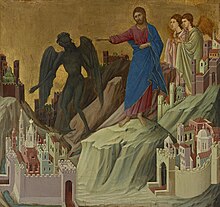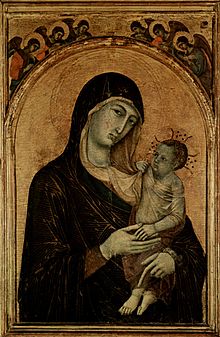Duccio di Buoninsegna
Duccio di Buoninsegna (* around 1255 probably in Siena , † 1319 in Siena) was an Italian painter.
Life
According to documented records, Duccio was first fined a large fine in 1280 for an unsubstantiated (but probably political) offense. Further penalties followed, such as in 1302 for financial debts, for the settlement of which he was commissioned to make a maestà for the town hall in Siena. However, this has not been preserved for posterity. Between 1296 and 1297 a Duche de Siene is mentioned in Paris , which suggests where Duccio and his successors got their Gothic influences from. From 1285 to 1299 he was mentioned several times in Siena and, among other things, punished for refusing to swear allegiance to the Capitano del Popolo . He was also punished for refusing to serve in the military and again for an apparently minor offense related to witchcraft .
Duccio was mentioned artistically for the first time in 1278 and 1279 with a work for the commune of Siena. He painted 12 chests of files. In 1285 a work by Duccio was created for the Florentine church of Santa Maria Novella , also known as Madonna Rucellai, which is now on display in the Uffizi in Florence ; it is the focus of an episode told by Giorgio Vasari in the 16th century, which Frederic Leighton painted in the 19th century ( Cimabue's celebrated Madonna is carried in procession through the streets of Florence ). In 1308 Duccio was commissioned to replace the old, highly venerated Madonna del voto , the old altarpiece in the Cathedral of Siena . The result was a larger, multi-part high altar painting, Duccio's “Maestà”. What Duccio then painted remains uncertain. He died in 1318 or 1319.
style
Duccio painted in the Byzantine tradition and gave it the human expression that was spread at that time by the painters of the Sienese school . He was considered an innovator and the expression of his characters was profound. His style was less naturalistic than that of his contemporary, Giotto di Bondone , who belonged to the Florentine school . Though a master of the storytelling technique that equated him with Giotto, he lacked iconographic originality.
Duccio often used the old Byzantine figures from the Old Testament as models for his scenes . His great craftsmanship, the use of gold as decoration and compositional property at the same time, the rich, subtle colors - which, in contrast to Giotto's form-describing nature, form an independent, aesthetic feature - as well as the varied and elegant contours, which are used to design the surface pattern as well as Describing the forms served shaped the Sienese school of painting for another two centuries.
Next-generation painters, such as Simone Martini or the brothers Pietro and Ambrogio Lorenzetti , although fundamentally different in their style, took Duccio's work as the basis for the development of their work.
Duccio's Maestà of the high altar of the Siena Cathedral
From 1308 a reredos for the high altar of the Cathedral of Siena was created. On June 9, 1311, the work Maestà of the high altar of the Cathedral of Siena , a Maestà , was completed. The front side is a magnificent Mother of God enthroned with child in a circle of angels and saints. The main panel is supplemented by a predella depicting Christ's childhood in seven fields, from the proclamation to the dispute with the scribes in the temple. On the back the Passion of Christ is depicted in twenty-six fields. In the predella below there are various miracles and stories from the life of Christ. In 1771 the front and back were separated and later there were regrettable dismantling. Eight predella tablets migrated abroad, where they are now kept in various collections and museums. A field of the predella is lost. The remaining parts - Maestà and the corresponding scenes on the reverse, as well as seven images of the predelle - are now in the Duomo Cathedral Museum in Siena .
Other works by Duccio or attributed to him are in the Frick Collection , New York , in the Royal Collection , Windsor , in the Christ Church Picture Gallery in Oxford , in Badia a Isola (municipality of Monteriggioni ) near Siena (a Madonna, often attributed to the master Badia a Isolas instead of Duccio himself), Bern , Turin , Budapest , London , Bologna , Perugia and Siena .
As a curiosity, it should be mentioned that Duccio painted a piglet as food on a picture of the Last Supper . This is anachronistic, since a pig was considered unclean by the Jews; the artist chose a typical dish of his time without considering the religious and historical context.
literature
- Ferdinando Bologna: Duccio di Buoninsegna. In: Fiorella Bartoccini (ed.): Dizionario Biografico degli Italiani (DBI). Volume 41: Donaggio – Dugnani. Istituto della Enciclopedia Italiana, Rome 1992.
Web links
- Literature by and about Duccio di Buoninsegna in the catalog of the German National Library
- Works by Duccio di Buoninsegna at Zeno.org .
| personal data | |
|---|---|
| SURNAME | Duccio di Buoninsegna |
| ALTERNATIVE NAMES | Duccio |
| BRIEF DESCRIPTION | Italian painter |
| DATE OF BIRTH | around 1255 |
| PLACE OF BIRTH | unsure: Siena |
| DATE OF DEATH | 1319 |
| Place of death | Siena |

